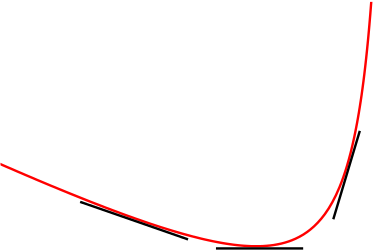Write down the equation of the line of gradient \(m\) through the point \((1, 2)\). Find, in terms of \(m\), the intercepts which this line makes on the two axes.
We can write the equation as \[y-2=m(x-1)\] or \[y=mx+2-m.\]
The \(y\)-intercept is at \(y=2-m\).
The \(x\)-intercept is given by \(0 = mx + 2 - m\), which yields \(x = 1-\dfrac{2}{m}\).
If \(m = 0\), the line is the horizontal line \(y = 2\), so there’s no \(x\)-intercept.
A line is drawn through the point \((1, 2)\) to form with the axes a triangle in the positive quadrant. Find the least possible area of the triangle.

Note that to form a triangle in the first quadrant, \(m\) must be negative.
The area of the blue triangle is \[A=\frac{1}{2}(2 - m)\left(1-\frac{2}{m}\right) = \frac{1}{2}\left(-m + 4 - \frac{4}{m}\right).\]
So the least area of the triangle is given by the minimum of the function \(A(m) = 2-\dfrac{m}{2}-\dfrac{2}{m}\).
We can sketch this graph by adding the curves \(y=2\), \(y= -\dfrac{x}{2}\) and \(y = -\dfrac{2}{x}\).

For a triangle to be created, \(m\) must be negative, so we’re looking for the minimum that we can see on the graph.
We can find the minimum by differentiating \(A\). We have \[\dfrac{dA}{dm}= -\dfrac{1}{2}+\dfrac{2}{m^2}.\]
Therefore \(\dfrac{dA}{dm}=0\) when \(m=\pm 2\). Since \(m\) has to be negative, \(m = -2\).
To check if this is a minimum point consider the gradients either side of \(m=-2\).

| \(m\) | \(-2.1\) | \(-2\) | \(-1.9\) |
|---|---|---|---|
| \(\dfrac{dA}{dm}\) | \(-\dfrac{1}{2}+\dfrac{2}{2.1^2}<0\) | \(0\) | \(-\dfrac{1}{2}+\dfrac{2}{1.9^2}>0\) |
So the least possible area of the triangle is \[A(-2) = 2-\frac{-2}{2}-\frac{2}{-2} = 4.\]
As an alternative to using calculus, we could notice that the two terms \(\dfrac{m}{2}\) and \(\dfrac{2}{m}\) multiply to one and that we are looking for the maximum of their sum.
This is a situation that crops up surprisingly often in mathematics and has a simple solution. It turns out that the maximum of \(\dfrac{m}{2}+\dfrac{2}{m}\) occurs when the two terms are equal.
To see why this is, you might think about the symmetry or you might think about the graphs of \(xy=1\) and \(x+y=k\).
Using this fact leads to the solution \(m=-2\) as above.
The graph of \(A(m)\) also has a stationary point at \(m=+2\). What does this correspond to geometrically?

